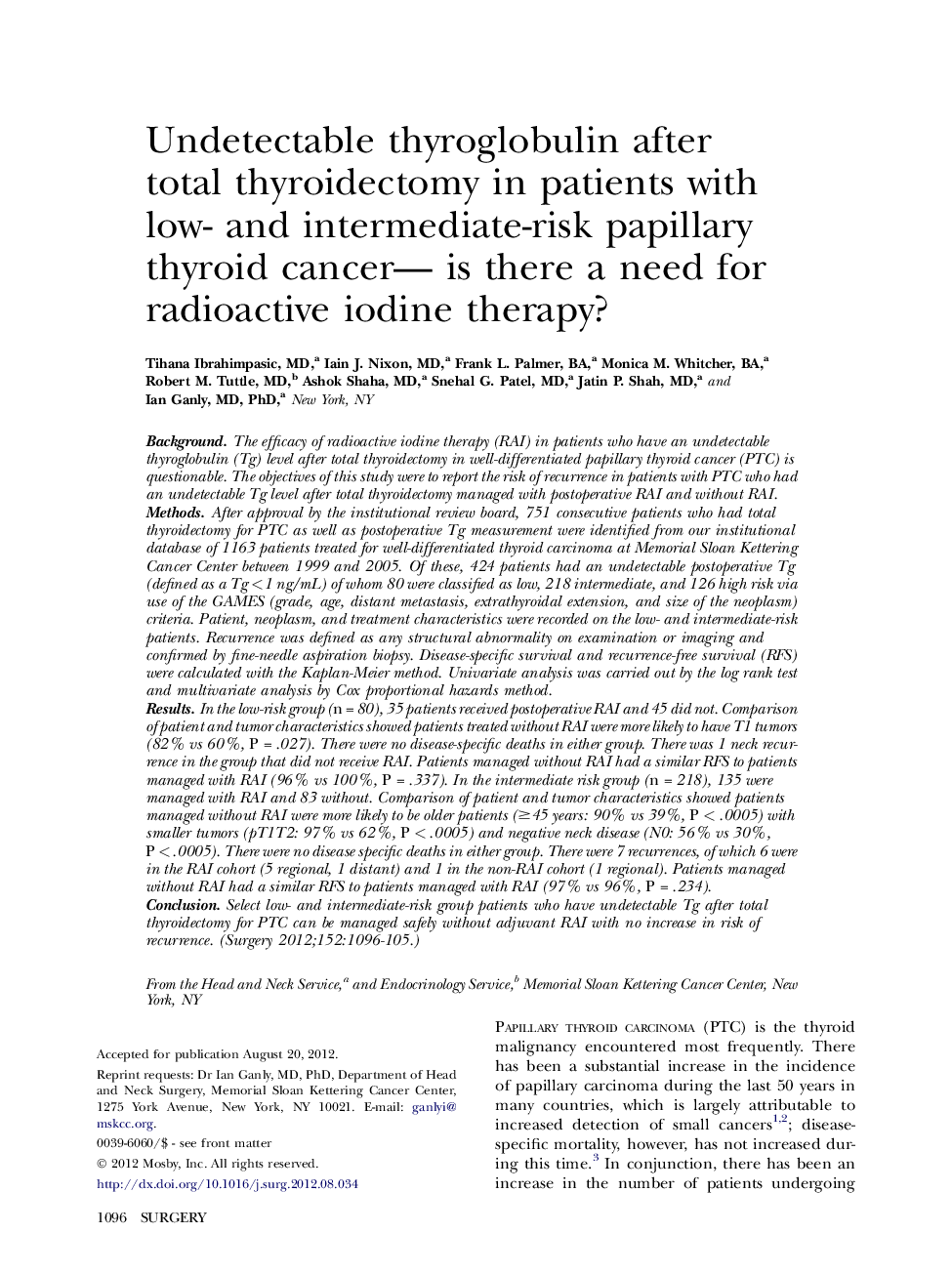| کد مقاله | کد نشریه | سال انتشار | مقاله انگلیسی | نسخه تمام متن |
|---|---|---|---|---|
| 4307730 | 1289255 | 2012 | 10 صفحه PDF | دانلود رایگان |

BackgroundThe efficacy of radioactive iodine therapy (RAI) in patients who have an undetectable thyroglobulin (Tg) level after total thyroidectomy in well-differentiated papillary thyroid cancer (PTC) is questionable. The objectives of this study were to report the risk of recurrence in patients with PTC who had an undetectable Tg level after total thyroidectomy managed with postoperative RAI and without RAI.MethodsAfter approval by the institutional review board, 751 consecutive patients who had total thyroidectomy for PTC as well as postoperative Tg measurement were identified from our institutional database of 1163 patients treated for well-differentiated thyroid carcinoma at Memorial Sloan Kettering Cancer Center between 1999 and 2005. Of these, 424 patients had an undetectable postoperative Tg (defined as a Tg <1 ng/mL) of whom 80 were classified as low, 218 intermediate, and 126 high risk via use of the GAMES (grade, age, distant metastasis, extrathyroidal extension, and size of the neoplasm) criteria. Patient, neoplasm, and treatment characteristics were recorded on the low- and intermediate-risk patients. Recurrence was defined as any structural abnormality on examination or imaging and confirmed by fine-needle aspiration biopsy. Disease-specific survival and recurrence-free survival (RFS) were calculated with the Kaplan-Meier method. Univariate analysis was carried out by the log rank test and multivariate analysis by Cox proportional hazards method.ResultsIn the low-risk group (n = 80), 35 patients received postoperative RAI and 45 did not. Comparison of patient and tumor characteristics showed patients treated without RAI were more likely to have T1 tumors (82% vs 60%, P = .027). There were no disease-specific deaths in either group. There was 1 neck recurrence in the group that did not receive RAI. Patients managed without RAI had a similar RFS to patients managed with RAI (96% vs 100%, P = .337). In the intermediate risk group (n = 218), 135 were managed with RAI and 83 without. Comparison of patient and tumor characteristics showed patients managed without RAI were more likely to be older patients (≥45 years: 90% vs 39%, P < .0005) with smaller tumors (pT1T2: 97% vs 62%, P < .0005) and negative neck disease (N0: 56% vs 30%, P < .0005). There were no disease specific deaths in either group. There were 7 recurrences, of which 6 were in the RAI cohort (5 regional, 1 distant) and 1 in the non-RAI cohort (1 regional). Patients managed without RAI had a similar RFS to patients managed with RAI (97% vs 96%, P = .234).ConclusionSelect low- and intermediate-risk group patients who have undetectable Tg after total thyroidectomy for PTC can be managed safely without adjuvant RAI with no increase in risk of recurrence.
Journal: Surgery - Volume 152, Issue 6, December 2012, Pages 1096–1105